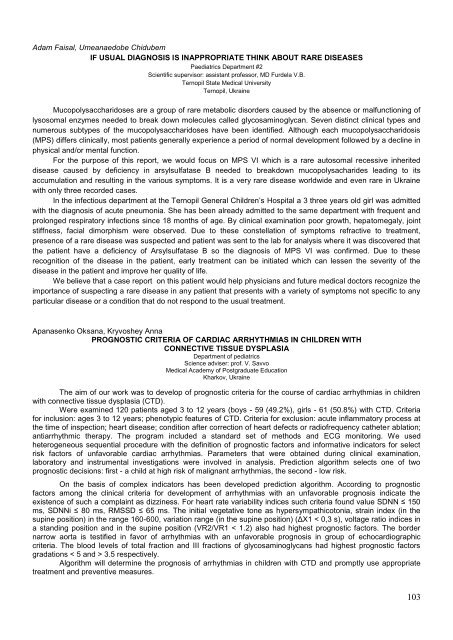ÐбÑÑник Ñез XVI ÐÑжнаÑодно медиÑного конгÑеÑÑ ÑÑÑденÑÑв Ñа ...
ÐбÑÑник Ñез XVI ÐÑжнаÑодно медиÑного конгÑеÑÑ ÑÑÑденÑÑв Ñа ...
ÐбÑÑник Ñез XVI ÐÑжнаÑодно медиÑного конгÑеÑÑ ÑÑÑденÑÑв Ñа ...
Create successful ePaper yourself
Turn your PDF publications into a flip-book with our unique Google optimized e-Paper software.
Adam Faisal, Umeanaedobe Chidubem<br />
IF USUAL DIAGNOSIS IS INAPPROPRIATE THINK ABOUT RARE DISEASES<br />
Paediatrics Department #2<br />
Scientific supervisor: assistant professor, MD Furdela V.B.<br />
Ternopil State Medical University<br />
Ternopil, Ukraine<br />
Mucopolysaccharidoses are a group of rare metabolic disorders caused by the absence or malfunctioning of<br />
lysosomal enzymes needed to break down molecules called glycosaminoglycan. Seven distinct clinical types and<br />
numerous subtypes of the mucopolysaccharidoses have been identified. Although each mucopolysaccharidosis<br />
(MPS) differs clinically, most patients generally experience a period of normal development followed by a decline in<br />
physical and/or mental function.<br />
For the purpose of this report, we would focus on MPS VI which is a rare autosomal recessive inherited<br />
disease caused by deficiency in arsylsulfatase B needed to breakdown mucopolysacharides leading to its<br />
accumulation and resulting in the various symptoms. It is a very rare disease worldwide and even rare in Ukraine<br />
with only three recorded cases.<br />
In the infectious department at the Ternopil General Children‘s Hospital a 3 three years old girl was admitted<br />
with the diagnosis of acute pneumonia. She has been already admitted to the same department with frequent and<br />
prolonged respiratory infections since 18 months of age. By clinical examination poor growth, hepatomegaly, joint<br />
stiffness, facial dimorphism were observed. Due to these constellation of symptoms refractive to treatment,<br />
presence of a rare disease was suspected and patient was sent to the lab for analysis where it was discovered that<br />
the patient have a deficiency of Arsylsulfatase B so the diagnosis of MPS VI was confirmed. Due to these<br />
recognition of the disease in the patient, early treatment can be initiated which can lessen the severity of the<br />
disease in the patient and improve her quality of life.<br />
We believe that a case report on this patient would help physicians and future medical doctors recognize the<br />
importance of suspecting a rare disease in any patient that presents with a variety of symptoms not specific to any<br />
particular disease or a condition that do not respond to the usual treatment.<br />
Apanasenko Oksana, Kryvoshey Anna<br />
PROGNOSTIC CRITERIA OF CARDIAC ARRHYTHMIAS IN CHILDREN WITH<br />
CONNECTIVE TISSUE DYSPLASIA<br />
Department of pediatrics<br />
Science adviser: prof. V. Savvo<br />
Medical Academy of Postgraduate Education<br />
Kharkov, Ukraine<br />
The aim of our work was to develop of prognostic criteria for the course of cardiac arrhythmias in children<br />
with connective tissue dysplasia (CTD).<br />
Were examined 120 patients aged 3 to 12 years (boys - 59 (49.2%), girls - 61 (50.8%) with CTD. Criteria<br />
for inclusion: ages 3 to 12 years; phenotypic features of CTD. Criteria for exclusion: acute inflammatory process at<br />
the time of inspection; heart disease; condition after correction of heart defects or radiofrequency catheter ablation;<br />
antiarrhythmic therapy. The program included a standard set of methods and ECG monitoring. We used<br />
heterogeneous sequential procedure with the definition of prognostic factors and informative indicators for select<br />
risk factors of unfavorable cardiac arrhythmias. Parameters that were obtained during clinical examination,<br />
laboratory and instrumental investigations were involved in analysis. Prediction algorithm selects one of two<br />
prognostic decisions: first - a child at high risk of malignant arrhythmias, the second - low risk.<br />
On the basis of complex indicators has been developed prediction algorithm. According to prognostic<br />
factors among the clinical criteria for development of arrhythmias with an unfavorable prognosis indicate the<br />
existence of such a complaint as dizziness. For heart rate variability indices such criteria found value SDNN ≤ 150<br />
ms, SDNNi ≤ 80 ms, RMSSD ≤ 65 ms. The initial vegetative tone as hypersympathicotonia, strain index (in the<br />
supine position) in the range 160-600, variation range (in the supine position) (ΔX1 < 0,3 s), voltage ratio indices in<br />
a standing position and in the supine position (VR2/VR1 < 1.2) also had highest prognostic factors. The border<br />
narrow aorta is testified in favor of arrhythmias with an unfavorable prognosis in group of echocardiographic<br />
criteria. The blood levels of total fraction and III fractions of glycosaminoglycans had highest prognostic factors<br />
gradations < 5 and > 3.5 respectively.<br />
Algorithm will determine the prognosis of arrhythmias in children with CTD and promptly use appropriate<br />
treatment and preventive measures.<br />
103
















